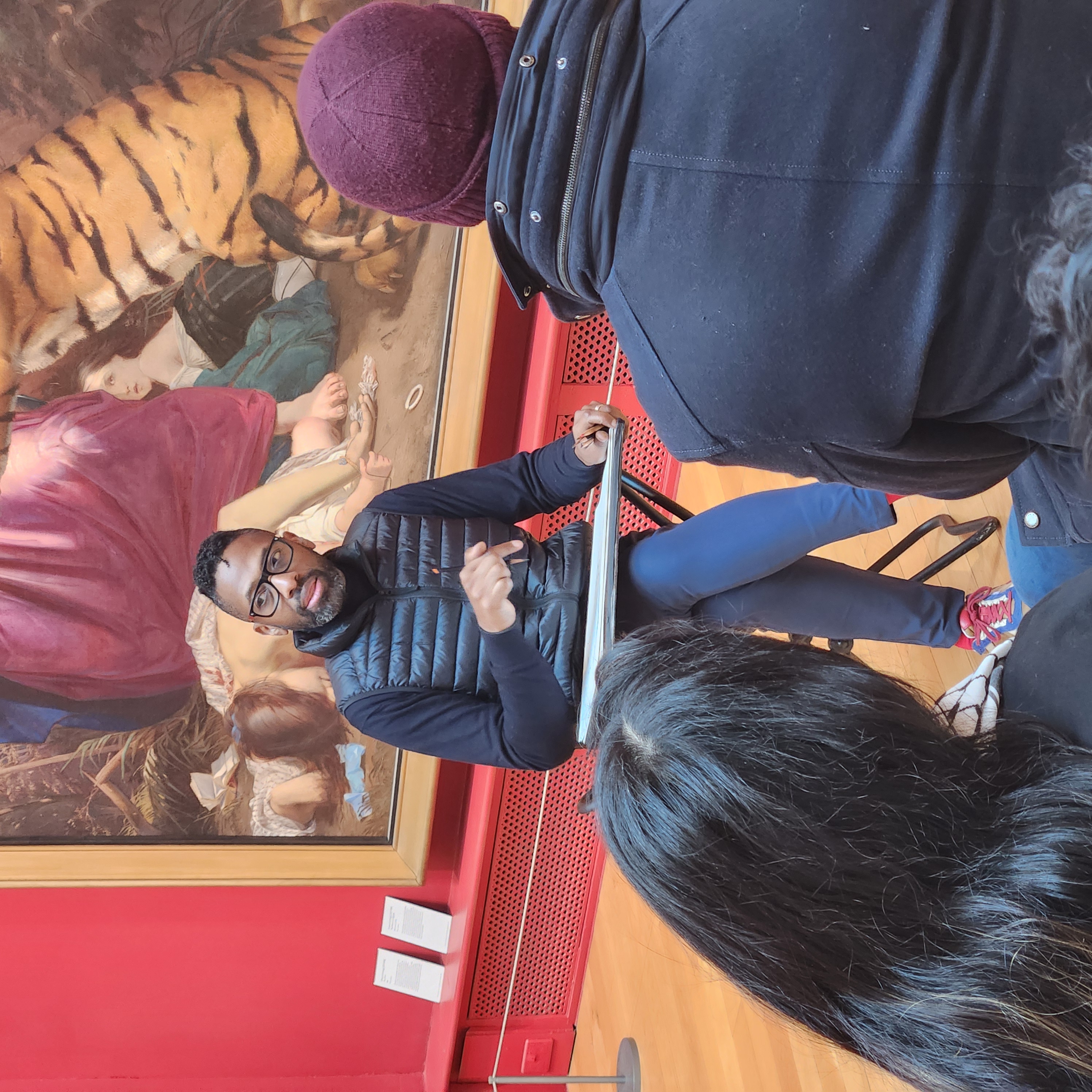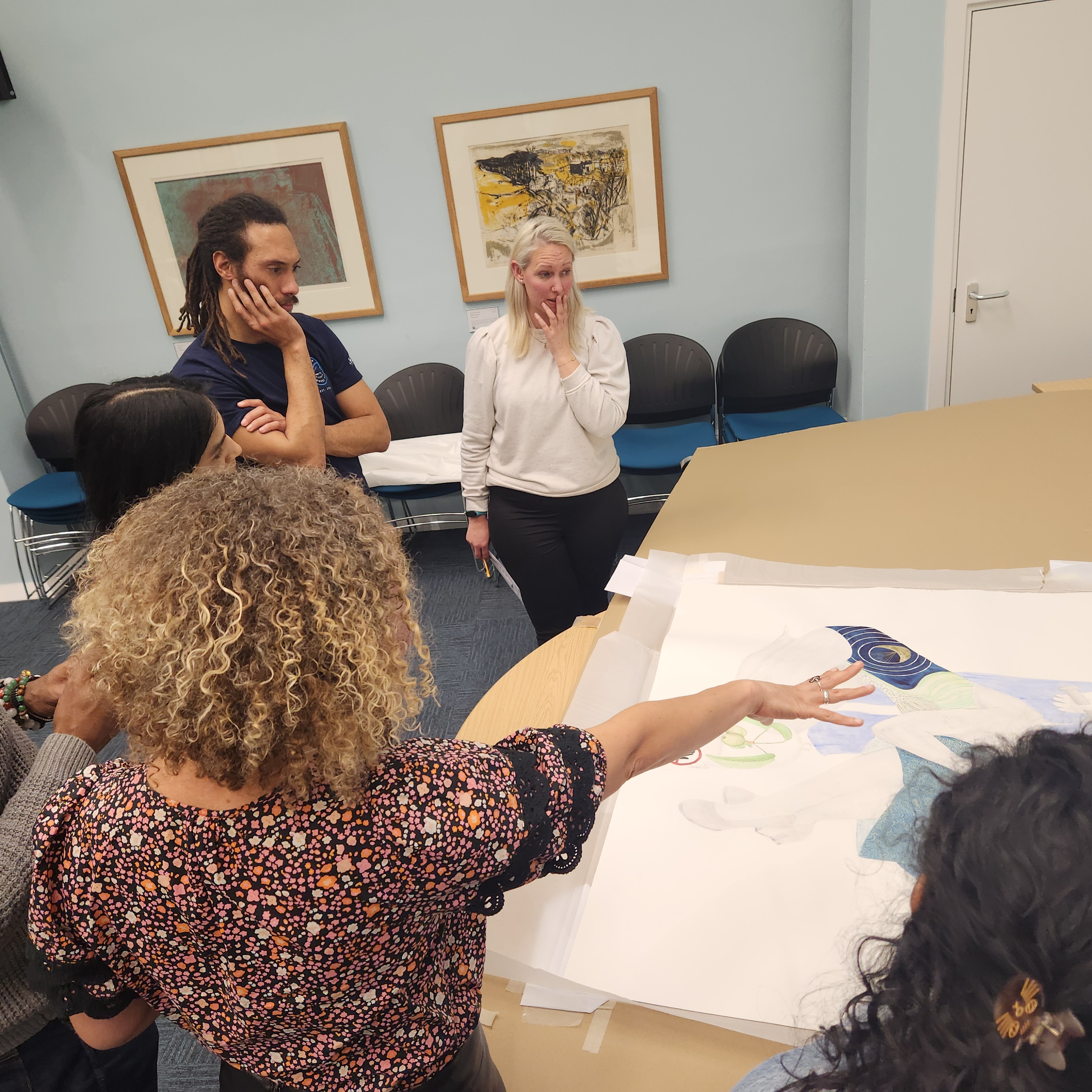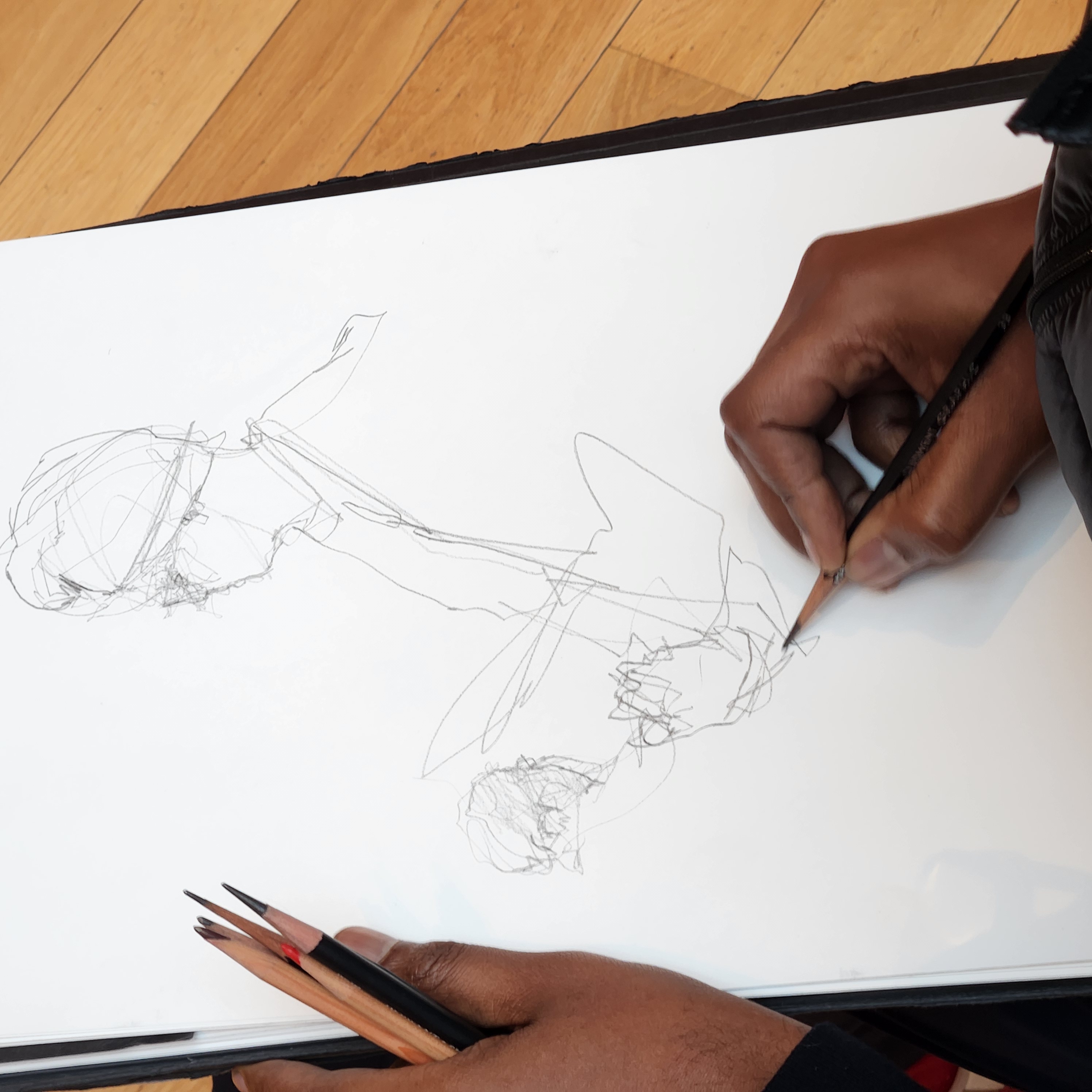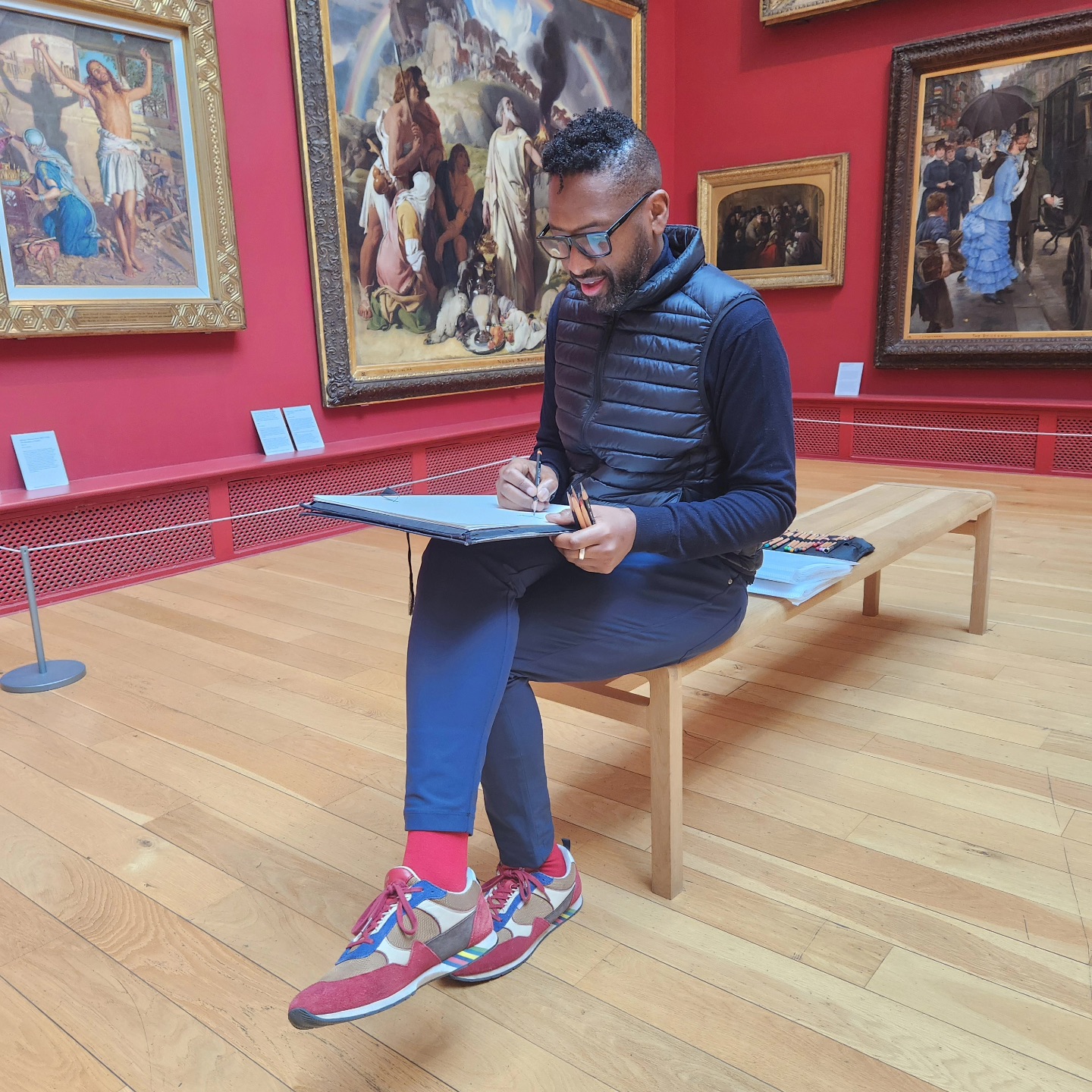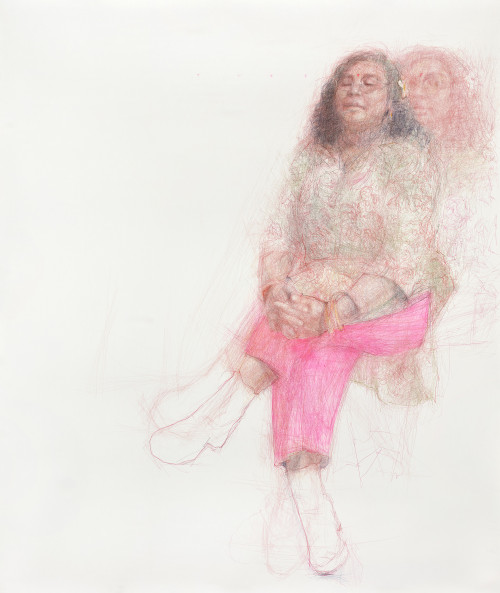
Curtis Holder, Tyvin Haque, 2024, coloured pencil and acrylic gouache on paper © Curtis Holder
My proposal for the 20/20 residency was to work with Leeds Art Gallery, its collection, staff and visitors, and eight sitters from the local community and Global Majority in Leeds to create a series of large multilayered portraits. I wanted to use the artworks in the gallery as a conversation starter to examine the repercussions of colonisation and the resulting dismantling of other cultures. Dialogue among our own communities and with the wider community is fundamental to begin healing from the trauma of the past and to move towards mutual understanding. This project aimed to bring together all voices connected with our shared colonial past to create something new and optimistic together.
My intention was to find eight sitters who were confident and motivated to engage in deep dialogue about the decolonisation of art, through the lens of their own experiences. As well as sharing in personal, reflective conversations during the sittings, the sitters were also asked to create their own responses to the project, and to contribute to a short film documentary about the process. This required honesty, bravery, and a distinct point of view, helping me to understand how the impact of colonisation has affected, and continues to affect, individuals within the Leeds community.
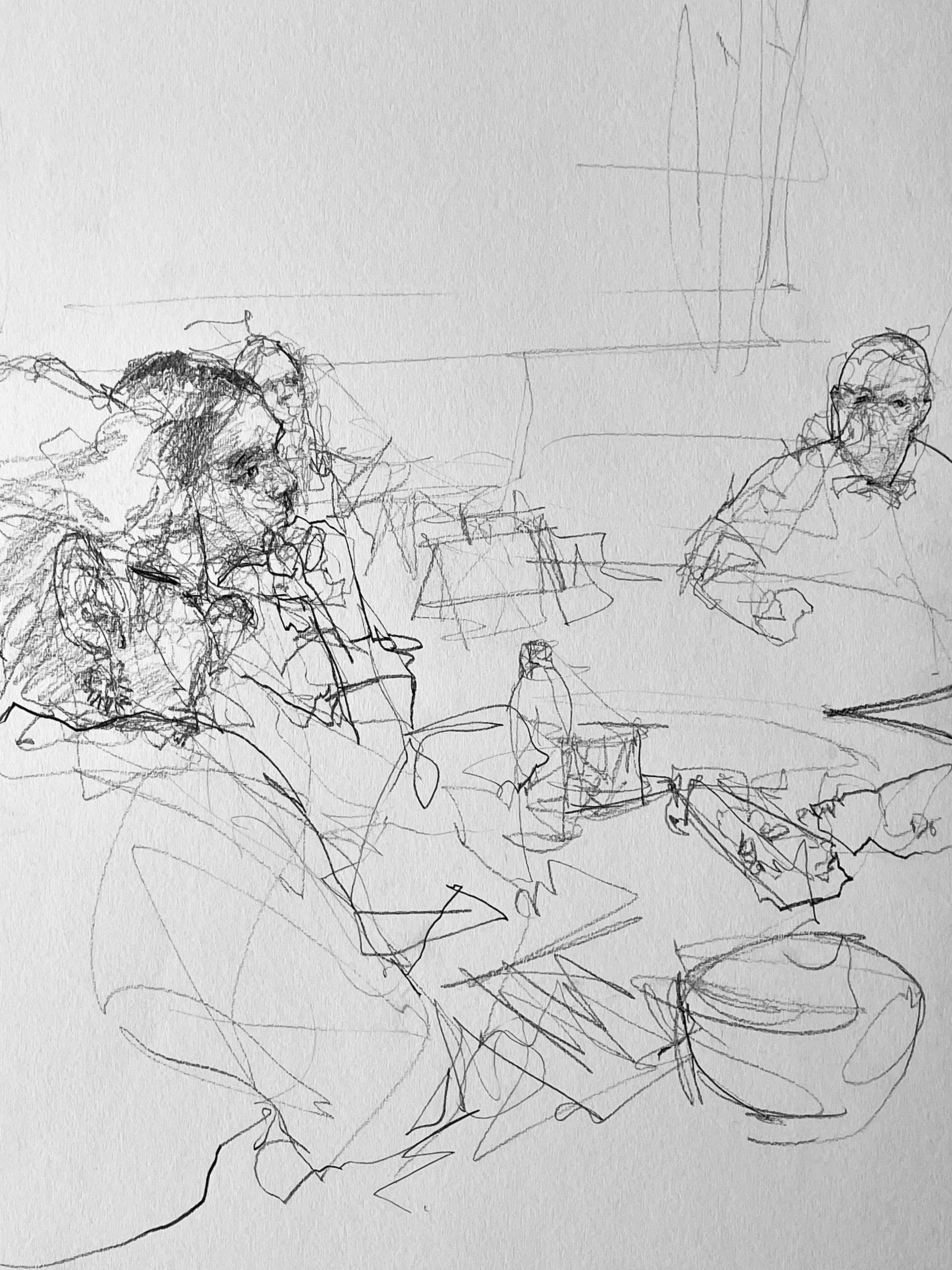
The support of the gallery was instrumental in helping me discover people who had links to the gallery, through workshops and community connections. This lead me to finding eight sitters for the portraits who were open and engaged with regard to the subject matter. It is a task that would have taken much longer to make happen if I had done it alone.
One thing I had not anticipated was how vast the community surrounding the gallery and its collection would be. I found engaging and working with different community projects extremely rewarding. The diverse nature of the gallery’s public programming and workshops meant I had the opportunity to connect with a diverse range of people, from the parent and toddler group to the dementia and their carers workshop. The fact that so many people were willing to collaborate with me was overwhelmingly positive, and provides evidence that an ongoing exploration these histories and stories could continue after this residency.
In terms of personal development, the residency has been a lynchpin in helping me understand the process of my own practice. It has also reaffirmed my innate ability to communicate deeply with my subjects, my sense of curiosity, and my long-held belief that the act of drawing can have a far-reaching impact beyond the final artworks themselves.
The residency has also provided the opportunity to bring a proposal to life from start to finish, addressing many questions on the topic of racial injustices in UK museums and galleries, and offering a insight into this subject through the eyes of individuals who were open to the concept.

Portrait sitting at Leeds Art Gallery with Tyvin Haque.
Working collaboratively with staff and curators at Leeds Art Gallery has given me an understanding of the workings of a government-run gallery, its advantages, and some of its challenges. I gained a real sense of the intricate and interwoven nature of the work, and the critical importance of collaboration. When it works well, it is a real force for positive community change, influencing how the public engages with art.
The experience at Leeds Art Gallery has had a cascading effect of opportunities. I have made connections with the curators and staff, their extended network, and the wider creative community of Leeds. This community is responsible for making the city a vibrant creative hub, and I now feel I will always welcome to participate in it.
The 20/20 project with UAL’s Decolonising Arts Institute has given me a clear route forward for my next body of work, and for future projects. I feel more confident when it comes to organising and prioritising aspects of my artistic process. Moving forward, I can structure my process into more defined stages, almost like a framework, while still retaining the instinctive emotional engagement with my subjects which is fundamental to the conversations I have and the work I create. The residency has been transformative, both practically and emotionally.
Partner Reflection
Leeds Art Gallery
Kirsty Young, Assistant Curator, Fine Art
Jane Bhoyroo, Principal Keeper
Working collaboratively with Curtis Holder on the 20/20 project has been a highly rewarding experience. It has enabled the team at Leeds Art Gallery to actively continue the work of Shifting Perspectives (2022), an exhibition that addressed racial injustice and interrogated our collection and ways of working, together with individuals from our local community who identify as being from the Global Majority. Curtis stated from the outset that he wanted to pick up where the exhibition left off which aligned with the gallery’s ambitions.
During his residency, Curtis has worked closely with some of the individuals involved in Shifting Perspectives; they have shared reflections on our collection and their own lived experiences. Curtis’s exhibition, Silent Echoes, Spoken Truths, will be presented at the Gallery from 8 November 2024 to 13 April 2025, where these individuals will have the opportunity to see themselves reflected through their portraits, the collection works they have selected and their own creative responses to the experience.
We are actively working to rewrite Leeds Museums & Galleries collections policy in light of the 20/20 project and we have a colonial histories working group through which we are addressing service-wide interpretation. We have shared Doing the Work with colleagues across the service, and will continue this process of reviewing texts throughout our work. Curtis has been involved in all aspects of our programme, and we worked closely to identify his sitters, who reflect the diversity of our work and have authentic relationships with the Gallery. During the initiation of the project, Curtis worked with a variety of established groups, highlighting the way we address social inequalities through our core work with teachers, young people who have been in care, and older people living with dementia, among others.
We have had conversations with Curtis throughout and, for many of the sitters, the experience has been highly emotive. This has heightened our awareness of the impact our exhibitions and programmes can have, teaching us to work constructively with positive and critical feedback regarding the collection and how we display it. We have been present when the sitters have viewed the works from the collection, allowing us to learn why particular works resonate with them, which is often a result of seeing themselves reflected, and the importance of this. We captured these reactions in our collections management, enabling us to see positive connections, but also those which people may find challenging, and emphasising the way that works can be starting points for conversation. This project has highlighted the importance of collecting information around artists and the content of their work, but also about the events and movements surrounding the time frame of production to add a deeper understanding of context.
Curtis has allowed a safe space for confidential discussions to take place in the Gallery while drawing the sitters, which has given some of them a new confidence. He has managed to make a difficult subject open and engaging. Curtis’s visibility and presence in the Gallery and on social media have raised the profile of this project, and his attendance at events – such as Nik Nak’s performance in Central Court – has widened his networks in this city, and he has mentored young Black artists with whom we have existing relationships. During the time of Curtis’s residency, we have acquired and shown works by Emii Alrai, Skye Davies, Ronald Moody, Veronica Ryan, Yinka Shonibare CBE and Dominique White.
The 20/20 meetings have been a safe place for discussion and developing a supportive network and a reminder of our commitment to Doing the Work, and that every member of staff has a responsibility to be proactive.
